

Until recently, a large body of the art of Gubbio in the early 14th century was attributed to Guiduccio Palmerucci, an artist who is known from documents. Until 1979, this corpus included an altarpiece (14th century) of the Madonna in Glory with Angels from from the Pieve d’ Agnano outside Umbertide, which was in the Museo Diocesano. However, its restoration at that point revealed the signature “Opus Melli de Eugubio” (the work of Mello da Gubbio). This provoked a series of re-attributions to this previously unknown artist.
Mello da Gubbio
This artist from Gubbio came into focus in 1979 after the discovery of his signature on a panel (14th century) in the Museo Diocesano that came from the Pieve d’ Agnano (see below). It is sometimes claimed (without documentary evidence) that Martino di Nello and Ottaviano Nelli were, respectively, his son and grandson.
[Frescoes recently discovered in San Francesco, Cagli after the 1997 earthquake]
Gubbio
Madonna in Glory with Angels (14th century)
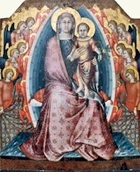
The Crucifixion (ca. 1500) on the back is by an unknown artist.
Madonna and Child (14th century)
This altarpiece in the Museo Diocesano, which came from the Pieve di Valdichiascio, is attributed to Mello da Gubbio.
St Antony Abbot (14th century)
This fresco on the left wall of Santa Maria Nuova is attributed to Mello da Gubbio.
Madonna and Child with saints (ca. 1340)
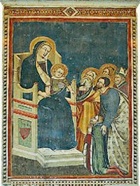
Madonna and Child (14th century)
This small tondo in the Pinacoteca Civica, which is attributed to Mello da Gubbio or Guiduccio Palmerucci, is of unknown provenance.
Perugia
Panels from a polyptych (14th century)
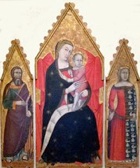
-
✴the central panel depicting the Madonna and Child: and
-
✴two side panels depicting:
-
•St John the Evangelist; and
-
•St Catherine of Alexandria.
Other panels from this polyptych in the the Museo Civico, Forlì depict SS Gregory and Mary Magdalene.
Guiduccio Palmerucci
Gubbio
Guiduccio Palmerucci might have been the son of Palmerino di Guido. He was documented in 1315 among a list of Ghibellines who were exiled from the city. He was exiled again in 1341 but allowed to return in the following year, on condition that he executed a number of frescoes in Palazzo dei Consoli. While most of these frescoes (including an Annunciation) have been lost, other surviving frescoes in the palace might belong to this programme.
As noted above, the large corpus of works attributed to him was considerably reduced in 1979, when one of them was found to have been signed by Mello da Gubbio.
Polyptych (ca. 1335)
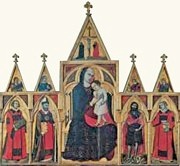
This polyptych the Pinacoteca Civica, which came from the Cappella Palatina of Palazzo dei Consoli, depicts the Madonna and Child enthroned with SS Marianus, Ubaldus, John the Baptist and James.

Three of its predella panels are in the Musée des Beaux Arts, Nancy, with an attribution to Mello da Gubbio. They depict the Crucifixion and two scenes of the martyrdom of SS Marianus and James.
Madonna and Child with saints (14th century)
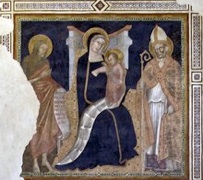
This fresco in situ at the foot of the stairs of Palazzo dei Consoli (now part of the Pinacoteca Civica) might have been part of Guiduccio Palmerucci’s decorative campaign of 1342. It depicts the Madonna and Child enthroned with SS John the Baptist and Ubaldus.
St Antony Abbot (14th century)
This fresco in the Museo Diocesano which was detached from an external niche on the right wall of Santa Maria dei Laici in 1964, is attributed to Guiduccio Palmerucci.
Crucifixion (14th century)
This fresco in a niche on the facade of the ex-church of San Bernardino, which was presumably painted for the Ospedale di Umile (a hospital that previously stood on the site), is attributed to Guiduccio Palmerucci.
Fresco [subject??] (14th century)
This fresco, which is attributed to Guido Palmerucci, is in the sacristy of Sant’ Ambrogio [not open].
Read more:
C. Ranucci, “MELLO da Gubbio”, Dizionario Biografico degli Italiani (Treccani) 73 (2009)
E. Neri Lusanna, “Precisazioni e Aggiunte alla Pittura Eugubina del Trecento”, Paragone, 36 (1985) 419-423
F. Santi, “Restauri ed Due un Ignoto Maestro del Trecento, Mello da Gubbio”, Bollettino d’ Arte, 64 (1979) 63-8

